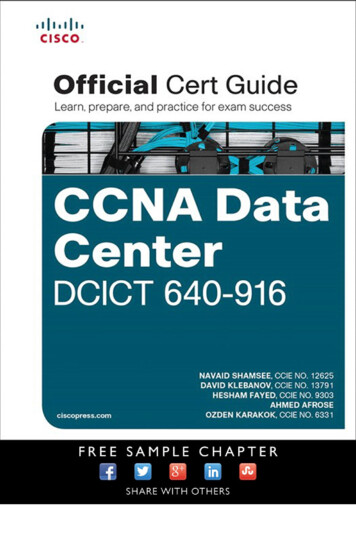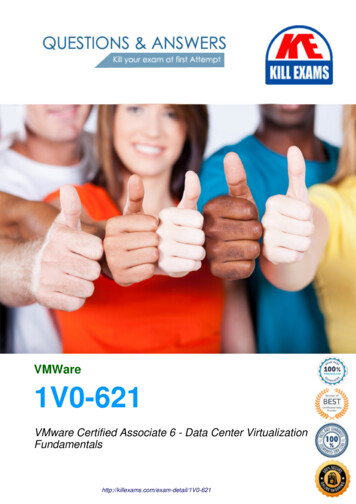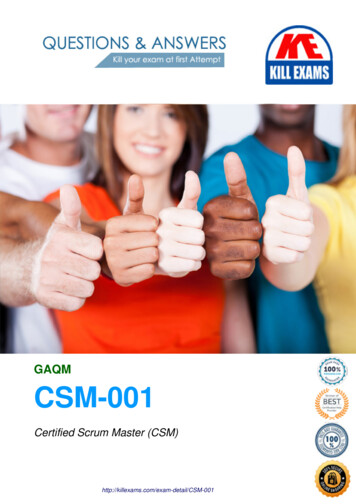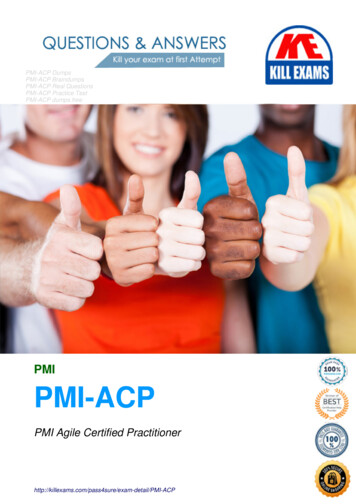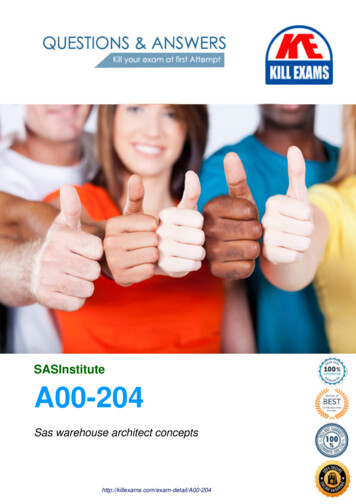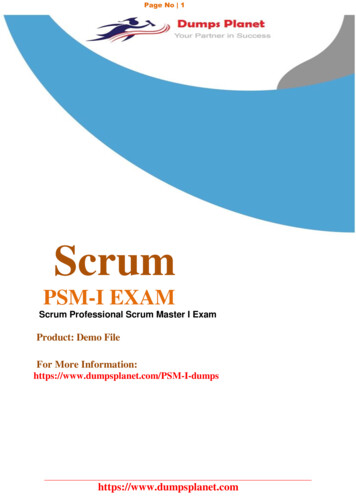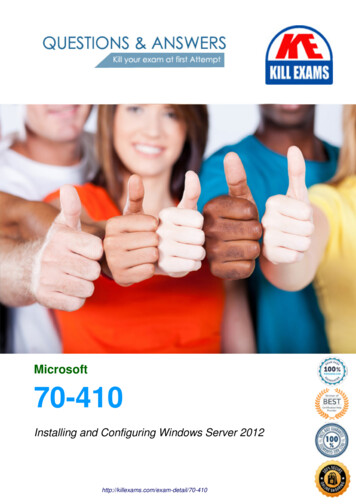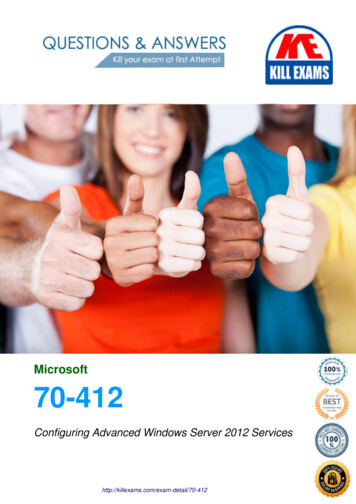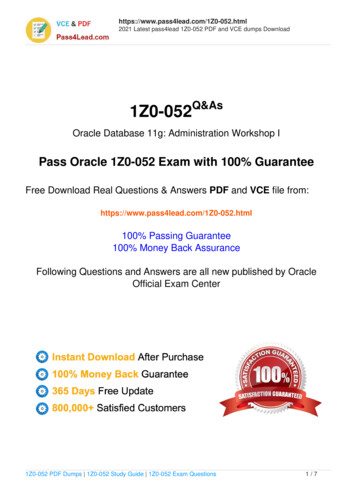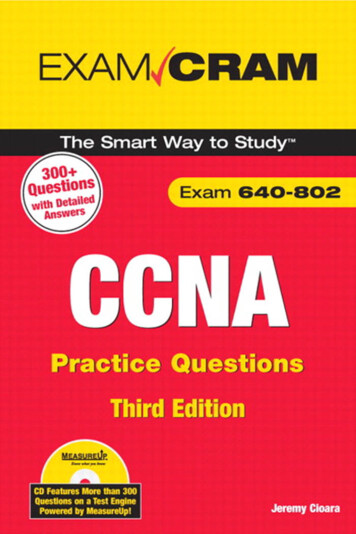
Transcription
CCNA Practice Questions (Exam 640-802), Third EditionAssociate PublisherDavid DusthimerCopyright 2008 by Que PublishingAll rights reserved. No part of this book shall be reproduced, stored in a retrieval system, or transmitted by any means, electronic, mechanical, photocopying, recording, orotherwise, without written permission from the publisher. No patent liability isassumed with respect to the use of the information contained herein. Although everyprecaution has been taken in the preparation of this book, the publisher and authorassume no responsibility for errors or omissions. Nor is any liability assumed for damages resulting from the use of the information contained herein.ISBN-13: 978-0-7897-3714-4ISBN-10: 0-7897-3714-0Library of Congress Cataloging-in-Publication DataCioara, Jeremy.CCNA practice questions (exam 640-802) / Jeremy Cioara. -- 3rd ed.p. cm.ISBN 978-0-7897-3714-4 (pbk. w/CD)1. Computer networks--Examinations--Study guides. 2. Computer networks-Examinations, questions, etc. 3. Electronic data processing personnel-Certification--Study guides. I. Title.QA76.3.C48 2008004.6--dc222008008365Printed in the United States of AmericaFirst Printing April 2008TrademarksAll terms mentioned in this book that are known to be trademarks or service markshave been appropriately capitalized. Que Publishing cannot attest to the accuracy ofthis information. Use of a term in this book should not be regarded as affecting thevalidity of any trademark or service mark.Warning and DisclaimerEvery effort has been made to make this book as complete and as accurate as possible, but no warranty or fitness is implied. The information provided is on an “as is”basis. The author and the publisher shall have neither liability nor responsibility to anyperson or entity with respect to any loss or damages arising from the information contained in this book or from the use of the CD or programs accompanying it.Bulk SalesAcquisitions EditorBrett BartowSenior DevelopmentEditorChristopherClevelandManaging EditorPatrick KanouseProject EditorSeth KerneyCopy EditorGeneil BreezeProofreaderKathy RuizTechnical EditorsIshaq MehrMichael ValentinePublishingCoordinatorVanessa EvansMultimediaDeveloperDan ScherfBook DesignerGary AdairPage LayoutTrudy ColerQue Publishing offers excellent discounts on this book when ordered in quantity forbulk purchases or special sales. For more information, please contactU.S. Corporate and Government or sales outside of the U.S., please contact:International Salesinternational@pearsoned.comThe Safari Enabled icon on the cover of your favorite technology book means the book is availablethrough Safari Bookshelf. When you buy this book, you get free access to the online edition for 45days.Safari Bookshelf is an electronic reference library that lets you easily search thousands of technicalbooks, find code samples, download chapters, and access technical information whenever and wherever you need it.To gain 45-day Safari Enabled access to this book:Go to http://www.quepublishing.com/safarienabledComplete the brief registration formn Enter the coupon code FNK3-N2NI-R1YB-NJJ3-FP91If you have difficulty registering on Safari Bookshelf or accessing the online edition, please e-mailcustomer-service@safaribooksonline.com.nn
IntroductionWhat Is This Book About?Welcome to the CCNA Practice Questions Exam Cram! The sole purpose of thisbook is to provide you with practice questions complete with answers and explanations that will help you learn, drill, and review for the 640-802, 640-822, and640-816 certification exams. The book offers a large number of questions topractice each exam objective and will help you assess your knowledge before youwrite the real exam. The detailed answers to every question will help reinforceyour knowledge about different issues involving the design and configuration ofCisco networks.Who Is This Book For?If you have studied the content for the 640-802, 640-822, or 640-816 exams andfeel you are ready to put your knowledge to the test, but you are not sure thatyou want to take the real exam yet, this book is for you! Maybe you haveanswered other practice questions or unsuccessfully taken the real exam,reviewed, and want to do more practice questions before retaking the real exam;this book is for you, too! Even when the exam is done and you have passed withflying colors and got the CCENT or CCNA certificate in your pocket, keep thebook handy on your desktop to look for answers to your everyday Cisco configuration issues.What Will You Find In This Book?As mentioned earlier, this book is all about practice questions! The practicequestions in the book, some easy and others containing more complicated problem scenarios, are all aimed at raising your confidence level before writing thereal exam. You will find questions that, in fact, you will face in real life.This book is organized according to the objectives published by Cisco for thefollowing exams:Exam 640-802: CCNAExam 640-822: ICND1Exam 640-816: ICND2
xCCNA Practice Questions (Exam 640–802)The book has been organized to help direct your study to specific objectives. Ifyou are studying only for the ICND1 exam (640-822), you only need to reviewChapters 1–6. If you are studying for the ICND2 (640-816) exam, you shouldfocus your studies on Chapters 7–11 (although, reviewing Chapters 1–6 may behelpful). If you are studying for the CCNA all-in-one exam, study through thewhole book!Each chapter corresponds to an exam objective, and in every chapter you findthe following three elements:. Practice Questions—These are the numerous questions that will help youlearn, drill, and review exam objectives. Some of the questions are multiple choice, others are matching (simulating the drag-and-drop stylequestions on the exam), and others are entering configurations (simulating the simulation style questions on the exam). Choose the correctanswer based on your knowledge of Cisco networks. Quick Check Answer Key—After you have finished answering the ques-tions, you can quickly grade your exam from this section. Only correctanswers are given in this section. No explanations are offered yet! Even ifyou have answered a question incorrectly, do not be discouraged. Justmove on! Keep in mind that this is not the real exam. You can alwaysreview the topic and do the questions again. Answers and Explanations—This section provides correct answers as wellas further explanations about the content posed in that question. Use thisinformation to learn why an answer is correct and to reinforce the content in your mind for the exam day.NOTEIt is not possible to reflect a real exam on a paper product. As mentioned earlier, thepurpose of the book is to help you prepare for the exam and not provide you with realexam questions. Neither the author nor Que Publishing can guarantee that you will passthe exam only by memorizing the practice questions given in this book.You will also find a Cram Sheet at the beginning of the book specifically writtenfor the exam day. The Cram Sheet contains core knowledge that you need forthe exam. The Cram Sheet condenses all the necessary facts found in the examinto an easy-to-handle tear card. It is something you can carry with you to thetesting center and use as a last-second study aid. Be aware that you cannot takethe Cram Sheet into the exam room, though!
xiIntroductionHints for Using This BookBecause this book is a paper practice product, you might want to complete yourexams on a separate piece of paper so that you can reuse the exams over and overwithout having previous answers in your way. Also, a general rule of thumbacross all practice question products is to make sure that you are scoring wellinto the high 80% to 90% range in all topics before attempting the real exam.The higher percentages you score on practice question products, the better yourchances for passing the real exam. Of course, we cannot guarantee a passingscore on the real exam, but we can offer you plenty of opportunities to practiceand assess your knowledge levels before you enter the real exam.When you have completed the exam on paper, use the companion MeasureUpCD to take a timed exam. This will further help you gain confidence and makea self-assessment in case you need more study. Your results will indicate theexam objectives in which you need further study or hands-on practice.Need Further Study?Are you having a hard time correctly answering these questions? If so, you probably need further review of all exam objectives. Be sure to see the following sister products to this book from Que Publishing:. CCNA Exam Prep (Exam 640-802) (2nd Edition) by Jeremy Cioara, DavidMinutella, and Heather Stevenson (ISBN 0789737132). CCNA Exam Cram (Exam 640-802) (3rd Edition) by Michael Valentineand Andrew Whitaker (ISBN 0789737124).
8CHAPTER EIGHTSubnetting, VLSM, andIPv6This chapter covers the following ICND2 objectives that fallunder the content areas, Implement an IP addressingscheme and IP Services to meet network requirements ina medium-size Enterprise branch office network:. Calculate and apply a VLSM IP addressing design to anetwork. Determine the appropriate classless addressing schemeusing VLSM and summarization to satisfy addressingrequirements in a LAN/WAN environment. Describe the technological requirements for runningIPv6 (including protocols, dual stack, tunneling, andso on). Describe IPv6 addresses. Identify and correct common problems associated withIP addressing and host configurations.
160Chapter 8 Quick Check1. Refer to Figure 8.1. The administrator wants to reduce the size ofthe Central router routing table. Which of the following summaryroutes would represent all the LANs in Tempe, with no additionalsubnets?Quick Answer: 175Detailed Answer: 176Network diagram.FIGURE 4172.17.1.0/24 A. 172.16.0.0/24 B. 172.16.0.0/23 C. 172.16.0.0/22 D. 172.16.1.0/24 E. 172.16.1.0/23 F. 172.16.1.0/22172.16.0.0/242. An Ethernet port on a router in your organization is assigned theIP address 10.65.64.1/21. What is the maximum number of hostsallowed on this subnet? A. 254 B. 510 C. 1022 D. 2046 E. 4094 F. 4096Quick Answer: 175Detailed Answer: 176
Subnetting, VLSM, and IPv6161 Quick Check3. Refer to Figure 8.2. All routers in the network have been configured with the ip subnet-zero command. Which subnet addressesshould be used for Network A and Network B? (Choose two.)FIGURE 8.2Quick Answer: 175Detailed Answer: 176Network diagram.NeoNetwork A100 92.168.1.32/27192.168.1.64/27 A. Network A – 192.168.1.112/25 B. Network A – 192.168.1.112/26 C. Network A – 192.168.1.128/25 D. Network B – 192.168.1.10/30 E. Network B – 192.168.1.70/30 F. Network B – 192.168.1.0/30Network BTrinity192.168.1.96/284. Which of the following are invalid IPv6 communication types?(Choose two.) A. Unicast B. Multicast C. Broadcast D. Anycast E. CryptocastQuick Answer: 175Detailed Answer: 176
162Chapter 8 Quick Check5. Which of the following are valid IPv6 addresses? (Choose three.) A. 2001:0db8:0000:0000:0000:0000:1428:57ab B. 2001:0db8::1428:57ab C. 2001::1685:2123::1428:57ab D. 2001:99:ab:1:99:2:1:9 E. 2001:1428:57ab:1685:2123:1428:57ab6. A router that is running both IPv4 and IPv6 addressing on thesame interface is known as what type of router? A. 6to4 B. 4to6 C. NAT-PT D. 4to6 tunneling E. Dual-stack7. RouterA is acting as an OSPF ABR between Area 1 and Area 0 asshown in Figure 8.3. Your organization wants to implement routesummarization capabilities between these two areas. Which of thefollowing describe the most efficient route summarization possibilities? (Choose two.)FIGURE 8.3Network diagram.OSPF Area 70.123.0/24OSPF Area 1RouterA10.170.0.0/2410.170.1.0/24Quick Answer: 175Detailed Answer: 176Quick Answer: 175Detailed Answer: 177Quick Answer: 175Detailed Answer: 177
Subnetting, VLSM, and IPv6163 Quick Check A. OSPF Area 0 – 10.170.0.0/16 B. OSPF Area 0 – 10.170.112.0/21 C. OSPF Area 0 – 10.170.112.0/20 D. OSPF Area 0 – 10.170.112.0/22 E. OSPF Area 0 – 10.170.120.0/22 F. OSPF Area 1 – 10.170.0.0/16 G. OSPF Area 1 – 10.170.0.0/21 H. OSPF Area 1 – 10.170.0.0/22 I. OSPF Area 1 – 10.170.0.0/238. You are designing an IP address scheme for your new remoteoffice. The vice president of IT calls to tell you that you will be incharge of the 192.168.1.64/26 subnetwork. This supplies you witha single subnetwork with 62 hosts. You need to have at least foursubnets with 14 hosts in each subnet. What custom subnet maskshould you use? Quick Answer: 175Detailed Answer: 177Quick Answer: 175Detailed Answer: 177A. 255.255.255.128 B. 255.255.255.192 C. 255.255.255.224 D. 255.255.255.240 E. 255.255.255.2489. Identify three valid host addresses in any subnet of the201.168.27.0 network, assuming a fixed subnet mask of255.255.255.240. (Choose three.) A. 201.168.27.33 B. 201.168.27.112 C. 201.168.27.119 D. 201.168.27.126 E. 201.168.27.175 F. 201.168.27.208Quick Answer: 175Detailed Answer: 177
164Chapter 8 Quick Check10. A new network is being designed for your company, Acme, Inc. Ifyou use a Class C IP network, which subnet masks will provideone usable subnet per department while allowing enough usablehost addresses for each department specified in the table?(Choose three.)DepartmentNumber of UsersCorporate117Customer Support15Financial25HR5Engineering5 A. 255.255.255.0 B. 255.255.255.128 C. 255.255.255.192 D. 255.255.255.224 E. 255.255.255.240 F. 255.255.255.248 G. 255.255.255.25211. You are troubleshooting your router’s interfaces. For some reason,the Ethernet interface will not accept the IP address of192.168.5.95/27 that you’ve assigned. Which of the followingexplains the router’s refusal to take the IP address? A. Class C addresses cannot be assigned to Ethernetinterfaces. B. The /27 is an invalid mask. C. It is a broadcast address. D. It is a network address. E. It is a public address. F. It is a private address.Quick Answer: 175Detailed Answer: 178Quick Answer: 175Detailed Answer: 178
Subnetting, VLSM, and IPv6 165Quick Check12. Your organization has moved to IPv6 addressing. The corporateoffice is connected to the two branch offices through the Internet,as shown in Figure 8.4. What tunneling type is this organizationusing?FIGURE 8.4Network diagram.TunnelCorporate HQ, IPv6elnTunInternet, IPv4Branch, IPv6 A. IPv6 VPN B. 6to4 tunneling C. 4to6 tunneling D. NAT-PT, VPN basedBranch, IPv6Quick Answer: 175Detailed Answer: 178
166Chapter 8 Quick Check13. Your organization has opened a new branch office, as shown inFigure 8.5. The corporation uses 10.0.0.0/8 addressing and wantsto use 172.16.X.X/24 address blocks for the branch offices. Thenew branch office will be large enough to require two of theseblocks. Which two blocks will be easily summarizable to a singlerouting table entry? (Choose two.)FIGURE 8.5Network diagram.Corporate HQ10.0.0.0/8 Addressing A. 172.16.111.0/24 B. 172.16.112.0/24 C. 172.16.113.0/24 D. 172.16.165.0/24 E. 172.16.166.0/24Branch172.16.x.x AddressingQuick Answer: 175Detailed Answer: 178
Subnetting, VLSM, and IPv6167 Quick Check14. Widget, Inc., uses the Class B address 172.30.0.0/16 to addressits organization. The western region of the organization (shown inFigure 8.6) has been allocated the 172.30.32.0/20 block. As theadministrator of the Phoenix office, you are required to allocatevalid subnets to the HQ and three branch offices shown in Figure8.6. Draw lines showing the subnet that should be assigned toeach office. All answers will not be used.Quick Answer: 175Detailed Answer: 179Network diagram.FIGURE 8.6Phoenix450 UsersCorporateNetworkSeattleEugene100 UsersSan Jose25 Users200 Users60 0.33.0/23172.30.33.128/25172.30.35.0/2515. Which of the following routing protocols support VLSM capabilities? (Choose three.) A. RIP B. RIPv2 C. EIGRP D. IGRP E. OSPFQuick Answer: 175Detailed Answer: 179
168Chapter 8 Quick Check16. XYZ Company has constructed the network shown in Figure 8.7.The company currently is using EIGRP with auto-summarizationfeatures enabled. How will routers in the corporate network seethe 172.16.x.x networks behind R1?FIGURE 8.7Network diagram.172.16.6.0/24172.16.2.4/30Corporate 2.0/30172.16.1.0/24R1R2172.16.5.0/24 A. Networks behind R1 will be summarized into a single172.16.0.0/16 entry. B. Networks behind R1 will be summarized into a single172.16.0.0/21 entry. C. The /24 networks behind R1 will be auto-summarizedinto a single 172.16.0.0/16 entry. The /30 WAN linknetworks will be auto-summarized into a single172.16.2.0/24 entry. D. The /24 networks behind R1 will be auto-summarizedinto a single 172.16.0.0/21 entry. The /30 WAN linknetworks will be auto-summarized into a single172.16.2.0/24 entry. E. EIGRP cannot handle VLSM configurations with autosummarization enabled. This network will experienceconnectivity issues.Quick Answer: 175Detailed Answer: 179
Subnetting, VLSM, and IPv6169 Quick Check17. An IPv6 address is a -bit address. A. 16 B. 32 C. 64 D. 128 E. 25618. In IPv6, Internet-valid addresses are known by what name? A. Private B. Public C. Unique D. Unspecified E. Global19. In IPv6, a address is used to communicate withhosts on the directly attached network and will never forwardbeyond the first router hop. Quick Answer: 175Detailed Answer: 179Quick Answer: 175Detailed Answer: 179Quick Answer: 175Detailed Answer: 180A. Global B. Private C. Link local D. Private restricted E. Auto-generated20. Which of the following commands could you use to assign anIPv6 address to your router? A. Router(config-if)#ip address fe01:3112:abcd::0001255.255.255.0 B. Router(config-if)#ip address fe01:3112:abcd::0001/48 C. Router(config-if)#ip address 6 fe01:3112:abcd::0001255.255.255.0 D. Router(config-if)#ip address 6fe01:3112:abcd::0001/48 E. Router(config-if)#ipv6 address fe01:3112:abcd::0001255.255.255.0 F. Router(config-if)#ipv6 addressfe01:3112:abcd::0001/48Quick Answer: 175Detailed Answer: 180
170Chapter 8 Quick Check21. Which of the following commands could you use to start a RIPngprocess on your router? A. Router(config)#router RIPng B. Router(config)#ipv6 router rip RIPng C. Router(config)#routerv6 RIP D. Router(config)#ripv622. TooCow University has acquired the 150.60.130.0/24 publicaddress from the local ISP to use in its campus network. Eachbuilding has a specific number of devices that are required to bepublicly accessible, as shown in Figure 8.8. Which of the followingsubnets would accommodate the network shown? (Choose four.)FIGURE 8.8Server Farm100 HostsNetwork diagram.Administration10 Hosts A. 150.60.130.128/26 B. 150.60.130.128/27 C. 150.60.130.96/27 D. 150.60.130.192/28 E. 150.60.130.32/27 F. 150.60.130.160/27 G. 150.60.130.16/28 H. 150.60.130.0/25College of Business20 HostsCollege of Education25 HostsQuick Answer: 175Detailed Answer: 180Quick Answer: 175Detailed Answer: 180
Subnetting, VLSM, and IPv6171 Quick Check23. Choose the most efficient summary address to encompass the following subnets:Quick Answer: 175Detailed Answer: 92.168.118.0/24192.168.119.0/24 A. 192.168.110.0/20 B. 192.168.110.0/21 C. 192.168.110.0/22 D. 192.168.112.0/20 E. 192.168.112.0/21 F. 192.168.112.0/2224. Choose the most efficient summary address to encompass the following subnets:Quick Answer: 175Detailed Answer: 28.0/24 A. 172.16.0.0/21 B. 172.16.4.0/21 C. 172.16.4.0/22 D. 172.16.0.0/1625. Is 172.20.2.255/23 a valid IP address? A. No, it is the broadcast address for the 172.16.2.0/24subnet. B. No, it is the broadcast address for the 172.16.2.0/23subnet. C. Yes, but you cannot assign the IP address to a host. D. Yes, and you can assign the IP address to a host.Quick Answer: 175Detailed Answer: 181
172Chapter 8 Quick Check26. Given the subnet 10.5.12.0/22, which of the following IP addresses are valid host addresses residing within the network? (Choosethree.) A. 10.5.14.253 B. 10.5.14.255 C. 10.5.13.0 D. 10.5.16.1 E. 10.5.16.227. Which of the following is a valid equivalent of the IPv6 address2001:0ab9:0000:0000:0003:0000:59ff:1ac5? A. 2001:0ab9::3::59ff:1ac5 B. 2001:ab9:0:0:3::59ff:1ac5 C. 2001:ab9::359ff:1ac5 D. 2001:0ab9: :3: :59ff:1ac5Quick Answer: 175Detailed Answer: 181Quick Answer: 175Detailed Answer: 181
Subnetting, VLSM, and IPv6173 Quick Check28. Your organization has decided to move forward with a completereaddressing of the entire network. Using Figure 8.9 as a guide,break the 172.18.0.0/16 network into initial allocations for theregions. Draw lines connecting the correct allocations to theregions.FIGURE 8.9Quick Answer: 175Detailed Answer: 182Network diagram.Central Region5500 AddressesWest Coast2000 AddressesEast Coast1000 172.18.32.0/21172.18.0.0/19172.18.16.0/2129. Observe the following output from the show run command:Current configuration : 104 bytes!interface FastEthernet0/0ip address 172.30.2.1 255.255.252.0no ip route-cacheno ip mroute-cacheendHow many host IP addresses are able to be used from the network to which this FastEthernet interface is connected? A. 255 B. 1022 C. 1024 D. 2046 E. 2048Quick Answer: 175Detailed Answer: 182
174Chapter 8 Quick Check30. Which of the following commands enables the IPv6 protocol on arouter? A. Router(config)#ipv6 unicast-routing B. Router(config)#ipv6 enable C. Router(config)#enable ipv6 D. Router(config)#ipv6 E. Router(config)#router ipv6Quick Answer: 175Detailed Answer: 182
Quick Check Answer KeyQuick Check Answer Key1. C12. B22. B, D, F, H2. D13. B, C23. E3. C, F14. See detailedanswer24. D4. C, E5. A, B, D6. E7. E, I8. D9. A, C, D10. B, D, F11. C15. B, C, E16. A17. D25. D26. A, B, C27. B18. E28. See detailedanswer19. C29. B20. F30. A21. B175
176Chapter 8Answers and Explanations1. C. 172.16.0-3.0/22 breaks down into the following binary equivalents:172.16.0.0 10101100.00010000.00000000.00000000172.16.1.0 10101100.00010000.00000001.00000000172.16.2.0 10101100.00010000.00000010.00000000172.16.3.0 10101100.00010000.00000011.00000000Based on these binary values, you can see that the first 22 bits on each one of theseIP addresses are the same. This makes the accurate summary address 172.16.0.0/22.All other answers are not valid.2. D. To find the valid number of hosts on a subnet, use the formula (2x) – 2, where “x”is the number of host bits in the subnet mask. A /21 (255.255.248.0) subnet mask has11 host bits. (211) – 2 2046. All other answers are not valid.3. C, F. These styles of VLSM are common on the ICND2/CCNA exam. It’s usually best toreverse-engineer the given subnets to see what ranges are in use and then comparethe answers to fill in what’s left over. In this case, the given ranges are:192.168.1.32-63/27 (Behind the Oracle router)192.168.1.64-95/27 (Behind the Morpheus router)192.168.1.96-111/28 (Behind the Trinity router)192.168.1.4-7/30 (Neo-Oracle WAN link)192.168.1.8-11/30 (Neo-Morpheus WAN link)With that given information, answer C (192.168.1.128-255/25) and answer F(192.168.1.0-3/30) best fit the scenario. Answers A, D, and E are incorrect becausethese are invalid subnet addresses. Answer B is incorrect because the /26 mask willonly provide 64 IP addresses, which is not sufficient for the size of Network A. Theseaddresses also overlap with the other office subnets.4. C, E. IPv6 uses three types of communication: Unicast (one-to-one), Multicast (oneto-many), and Anycast (one-to-closest). Answer C is incorrect because the concept ofBroadcast messaging is tied with the IPv4 protocol and is no longer valid in IPv6.Answer E is incorrect because there is no such thing as Cryptocast messaging.5. A, B, D. An IPv6 address consists of eight octets that can be four hexadecimal characters each. Consecutive sets of zeros can be abbreviated with a double colon (::), butthis can only be used once in each IP address. Leading zeros can also be dropped.Based on these rules, addresses from the question can be described as:2001:0db8:0000:0000:0000:0000:1428:57ab (Valid, eight octets)2001:0db8::1428:57ab (Valid, same address as above with abbreviation)2001::1685:2123::1428:57ab (Invalid use of double colon)2001:99:ab:1:99:2:1:9 (Valid, dropped leading zeros)2001:1428:57ab:1685:2123: 1428:57ab (Invalid, only seven octets)
Answers and Explanations1776. E. A dual-stack router can receive requests from both IPv4 and IPv6 clients on thesame interface. This provides a smoother transition between the two protocols.Answers A, B, and D are incorrect because these all describe tunneling methods (IPv4tunneled through an IPv6 network 4to6). Answer C is incorrect because thisdescribes a newer form of NAT that is able to translate between IPv4 and IPv6addressing.7. E, I. 10.170.120-123.0/24 breaks into the following binary equivalents:10.170.120.0 00001010.10101010.01111000.0000000010.170.121.0 00001010.10101010.01111001.0000000010.170.122.0 00001010.10101010.01111010.0000000010.170.123.0 00001010.10101010.01111011.00000000Based on this, we can see that the first 22 bits of each subnet are the same, thus thesummary address is 10.170.120.0/22 for Area 0 (answer E). 10.170.0-1.0/24 breaksinto the following binary equivalents:10.170.0.0 00001010.10101010. 00000000.0000000010.170.1.0 00001010.10101010. 00000001.00000000Based on this, we can see that the first 23 bits of each subnet are the same, thus thesummary address is 10.170.0.0/23 (answer I). All other answers are not valid.8. D. This subnet mask gives you four additional subnets using VLSM, with up to 14hosts per subnetwork. Answer A is incorrect, as it is a higher subnet mask than youroriginal /26, which is actually called supernetting. Answer B is incorrect because it isyour original subnet mask. Answer C is incorrect, as it does not give you enough subnets. Answer E is incorrect, as it gives you enough subnets (six), but you would haveonly six hosts.9. A, C, and D. A subnet mask of 255.255.255.240 divides the fourth octet into subnetparts: the highest four bits and a host port (the lowest four bits). You simply check thefourth octet to ensure that all subnet and host parts are okay. The host bit portion cannot be 0000 or 1111. Answers A, C, and D are correct because 33 in decimal is00100001, 119 in decimal is 01110111, and 126 in decimal is 1111110. Answer B isincorrect, as 112 in decimal is 1110000 in binary. This is not a valid host address inthis network. All its host bits are zero. Answer E is incorrect, as 175 in decimal is10101111 in binary. All host bits are ones. This is the local broadcast address andcannot be used as a host address. Answer F is incorrect, as 208 in decimal is11010000 in binary. This is not a valid host address in this network, and all its hostbits are zero.
178Chapter 810. B, D, F. The departments will use the following subnet masks:DepartmentNumber of UsersSubnet MaskCorporate117255.255.255.128 (126 hosts)Customer Support15255.255.255.224 (30 hosts)Financial25255.255.255.224 (30 hosts)HR5255.255.255.248 (6 hosts)Engineering5255.255.255.248 (6 hosts)All other answers are invalid.11. C. It is not a valid host address; 192.168.5.95/27 is a directed broadcast address forthe 192.168.5.64 network. Answer A is incorrect, as you can certainly assign Class Caddresses to any type of interface. Answer B is incorrect, as the /27 mask is the255.255.255.224 subnet mask, which is perfectly valid. Answer D is incorrect because192.168.5.95/27 represents a broadcast address rather than a network address.Answer E is incorrect because it is a private IP address. Answer F is incorrect, as thefact that it is a private IP address will not cause it to be refused by an interface.12. B. One of the IPv6 transition schemes includes an IPv6 to IPv4 (6to4) tunnelingmethod. This allows you to tunnel your IPv6 networks through an IPv4 network.Answer A is incorrect because the VPN is actually using the IPv4 Internet as its connection point. Answer C is incorrect because 4to6 tunnels involve IPv4 networks tunneling through an IPv6 network. Answer D is incorrect because NAT-PT is a form ofNAT that can handle translations between protocol suites. It is not related to VPN technology.13. B, C. 172.16.112.0/24 and 172.16.113.0/24 can be summarized into the single entry172.16.112.0/23. Answers A, D, and E represent addresses that cannot be summarized into a single routing entry that only encompasses two of the /24 network ranges.
Answers and Explanations17914.FIGURE 8.10Network diagram.Phoenix450 n 25 Users60 Users200 Users172.30.33.0/24172.30.33.0/23100 515. B, C, E. RIPv2, EIGRP, and OSPF all support Variable Length Subnet Mask (VLSM)capabilities. Answers A and D are incorrect because RIPv1 and IGRP are classful routing protocols and do not support VLSM.16. A. When auto-summarization is enabled, EIGRP will summarize networks back to theirclassful boundary anytime a discontiguous network is reached (such as the transitionfrom 10.0.0.0/8 networks to 172.16.0.0/16 networks). In this case, R1 will summarizethe corporate network back to 10.0.0.0/8 as it passes the routing update to R2. It willalso summarize all the 172.16.x.x networks back to 172.16.0.0/16 as it passes therouting update into the corporate network. Answers B, C, and D are incorrect becauseauto-summarization only summarizes back to a classful boundary rather than to morespecific subnet
x CCNA Practice Questions (Exam 640–802) The book has been organized to help direct your stu
